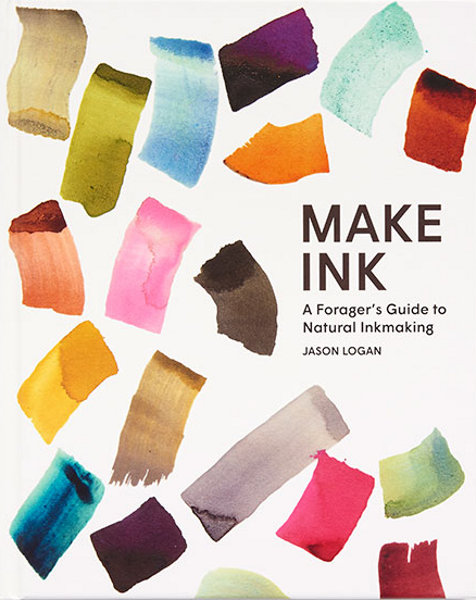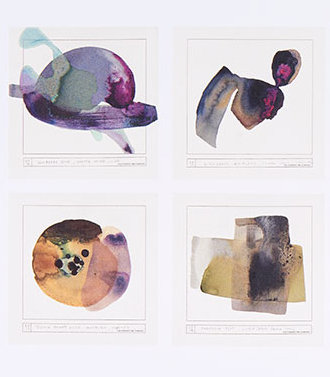
image copyright Lauren Kolyn, courtesy of Abrams publishing
Make Ink, A Forager's Guide to Natural Inkmaking
.
If you have any comments, observations, or questions about what you read here, remember you can always Contact Me
All content included on this site such as text, graphics and images is protected by U.S and international copyright law.
The compilation of all content on this site is the exclusive property of the site copyright holder.
Make Ink: A Forager's Guide to Natural Inkmaking
by Jason Logan
Look for a definition of foraging and you will learn that "Foraging is searching for wild food resources" or "The acquisition of food by hunting, fishing, or the gathering of plant matter." Well and good, but why limit foraging to edible items. Broaden "gathering" from just edibles to any material collected from nature. Now consider crafts such as basketry. And dyestuff. All the world is color. The secret is to coax the color out from where and what contains it.
Perhaps as a child you picked mulberries and came home with purple stained fingers. Yes? Think ink! You accidentally spilled some tea on the page of a book. The resulting light brown stain should again have you thinking of ink. Jason Logan is enthusiastic and happy to share tips and techniques for making ink from natural material in his book,

image copyright Lauren Kolyn, courtesy of Abrams publishing
Make Ink, A Forager's Guide to Natural Inkmaking
The book opens with an introduction, Jason is wandering through New York City looking for ingredients with which to make ink for a New York Times Facebook event live event.
It reads like a letter from a long time friend, or a diary entry. Jason is open and sharing, welcoming us to join in his discoveries. It's his personal journey down city streets, into weed filled lots, highway underpasses with crumbling old metal, where the alchemist explores and learns to make color from berries and flowers, gray coaxed from acorn caps, mineral colors from the earth, rust and vinegar to blacken and make permanent the ink made from oak galls, just as did the monks in medieval times.
After the introduction comes On Foraging. It's an invitation to explore rather than a restrictive prescription. Do watch out for poison ivy but otherwise be open to possibilities, any / everything from cigarette butts to a purple blight on lamb's quarters. Options, Jason explains, include bark for tannins, inner bark has pigments, sap might be a binder, leaves buds flowers fruit berries lichens nuts
Enticing images accompany the text, sometimes of plants or other materials for inky options, a winter landscape accompanies a page on foraging in winter.
Now that stuff has been gathered, it is time to make ink. But first, what is ink and how is it made. Jason explains: "What distinguishes ink from other art supplies is its use as a tool for communication." And communication is something Jason does quite well. Here's what he did to start up his ink company, here's what you need to begin making ink, these are some other items it might be nice to have. And do keep a notebook of what was foraged, how the ink was brewed, and what were the results. If good, you'll want to replicate it. And if not good your notes might provide ideas for tweaks to improve your ink.
Getting down to it with a basic recipe suggests some generic options such as berries, charcoal, leaves and other possibilities. Technique(s) for creating color from your ink stuff. A series of pictures guides the novice ink maker through the process. And lastly, clean up. Two paragraphs on thickeners and binders, one about water, something about glass (containers, funnels, bottles), pigments - rocks, minerals, metals as opposed to biologicals - plant based color.
 .
.
image copyright Lauren Kolyn, courtesy of Abrams publishing
Options and possibilities displayed in colorful, artistic swirls and swipes
Colors and recipes has a two page spread of - lets call them test strips - on end with color and name of ingredient plus date. Why date? You'll want to know how fast, how permanent your ink is over time. This, the main portion of the book has multi page entries and images arranged by color - black from grape vines turned into charcoal by barbecuing twiglets in a closed Altoids tin. Blacker from oak galls . . .
A line in Naomi Novik's stand alone fantasy novel Uprooted reaches out to me: "Maybe some poor scribe or book-binder had wandered too close to the Wood, and under the boughs pounded fallen leaves into paper, brewed ink out of oak galls and water . . ." Aha! Now I understand.
Brown. Red. Purple . . . Ink from wild grapes. No where to forage them?

image copyright Lauren Kolyn, courtesy of Abrams publishing
Concord grapes are in the stores in early September.
I use some to make jelly, could use others make ink.
Other colors, where to find them, suggestions to extract them.

image copyright Lauren Kolyn, courtesy of Abrams publishing
Yellow from spice cabinet, turmeric for a rich yellow.
And then a mesmerizing section, page after page of images displaying Jason's inks tested on paper. Page after page of collaborations with artists, images abstract, cartoonish, written, imaginative.
Make Ink wraps up with a multi page conversation between Jason and Michael Ondaatje, a Canadian author and poet who also wrote the foreword for Make Ink. Michael writes in long hand, no machine interface between person and paper.
In Eliot Pattison's post-apocalyptic novel, Ashes of the earth: "He lifted a piece of empty paper waiting beside Nelly's books, admiring the weight and texture. It was handmade. " . . . "An artisan in the northern settlements sends it. It holds the color of our berry inks perfectly." And later in the conversation between Hanibal and Nelly, after she shows him an old, salvaged, portable typewriter, "I dab pokeweed ink onto the ribbon," she explained. " Hmmm.
There is a table of contents up front, but no index in the back of the book. There is a history, a time line of ink, and a glossary of terms. The next edition might helpfully include a glossary of botanicals for ink making, with page references.
Make Ink is not going to teach you how to make a ball point pen. And though I do not understand how, after reading this book perhaps you still do not want to make ink. It is still a fascinating read for anyone who enjoys exploring in nature and the natural world.
Make Ink, A Forager's Guide to Natural Inkmaking
by Jason Logan
published by Abrams, 2018
ISBN 978-1-4197-3243-0
Hardcover, $29.99
A review copy of this book was provided by the publisher
Back to Top
Back to August
Back to the main Diary Page